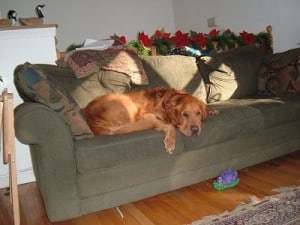Usually very high on the list of training priorities for a Golden Retriever puppy or a dog is the issue of house training.
Training Golden Retriever to avoid eliminating in the house is important for several reasons – the most obvious of which is the odour and mess that a non-house broken dog will make.
Crate Training
One of the most successful ways to train a puppy is to use the crate training method.
The crate is seen by the dog as a safe area or den that he or she can use to sleep in, or just to spend time.
There are several benefits to crate training your puppy that will continue to be useful as your dog matures.
A crate provides an excellent environment for transporting your Golden Retriever, a comfortable yet confined place when you are not at home, a method to control challenging behaviours such as digging and chewing, as well as a tool for scheduling toileting, sleeping and other activities.
It is important to allow your Golden Retriever puppy to adjust to the crate and to learn that the crate is a good place to be, not a punishment.
Start by placing the crate on the floor, and place inside some dog treats and toys.
- Close the door, and let the puppy sniff around the crate. The puppy will soon realize the treats are on the inside, and will whine or scratch to get into the crate.
- Praise the dog for wanting in, and open the door. Leave the door open, but don’t praise the dog for coming out. The puppy needs to learn that inside is better than outside.
- To get the puppy to go back into the crate have a few more treats and toss them towards the back of the crate.
- Positively reward the puppy for walking in and eating them.
- Gradually begin to close the door behind the puppy. If the puppy does start to whine or bark make sure that you do not let him or her out until there is quiet, or you will be reinforcing the whining behaviour.
- Always have a treat or two inside the crate, and start saying “Crate” to alert the puppy to go in for a treat.
- Never force the puppy into the crate or it will start to be seen as a punishment.
- Increase the time in the crate but do not exceed thirty minutes to avoid any accidents or stress on the puppy.
- If your Golden Retriever is kept in the crate for longer than the time it can control its bladder, it will begin to mess in the crate. This creates a bad habit and will seriously affect the ability of the puppy to learn to eliminate only when outside or in a designated area.
To start the crate training process, take the puppy out of the crate every hour and allow them access to the outside area. As soon as the puppy does urinate or defecate, provide immediate praise and attention. If the puppy does not do anything, return them to the crate and try again the next hour.
As the puppy gets older and has better control of bowels and bladder, the time between crating will increase. Usually in two to three weeks after starting crate training the puppy will be basically housetrained.
Be aware that mistakes and accidents will happen, despite the best scheduling and planning. Try to clean up the mess as quickly as possible.
Avoid punishing the dog as this will lead to anxiety and more accidents. Make sure to reward and praise the dog for the next successful outing, instead.
Crate training should only be used if you are able to get to the puppy to allow them out when needed. If you are unable to be with the puppy at this time, crate training may not be the best method.
Avoid using crate training techniques if the puppy is vomiting or has diarrhea, or if they have any difficulty controlling their bowels or bladder.
Check with a vet and get medical support before deciding if crate training is right for your puppy if it is having control problems.
Crate training can also be used as a quick 30 second time out area if the puppy is overexcited or not listening.
Avoid using the crate too often or for long periods of time as a punishment, as it will no longer be a positive and secure place for the puppy.
Too much time in the crate will limit the socialization of the puppy, and will also decrease the amount of exercise the puppy has.

